Dr. Carol K. Winkler, Dr. Cori E. Dauber
U.S. Army War College and
Georgia State University
Key Insights:
• Visual images have real power that is separate from the words with which they appear and need to be studied distinctly from those words, using methods developed specifically for dealing with images.
• The study of visual images is especially important in the online environment, where most terrorist and extremist groups of concern to the U.S. produce a great deal of material that is primarily visual in nature.
• For these materials, ignoring or misunderstanding the visual element will ultimately mean misunderstanding the propaganda item under consideration, which will make it difficult if not impossible to produce effective counter-propaganda.
The Visual Propaganda and Online Radicalization Conference was held at the Loudermilk Conference Center in Atlanta, Georgia, from March 14-16, 2012. The conference began with private meetings where conference presenters and other faculty contributors shared their research findings for a forthcoming edited monograph, tentatively entitled, Visual Persuasion and Extremist Propaganda in the Online Environment. Carol Winkler and Cori Dauber will serve as co-editors of the monograph for the Strategic Studies Institute (SSI), expected in 2012-13.
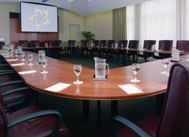 During the private sessions, each contributing author presented a chapter outline and received a prepared response by one of the other participants. After each of these segments, each chapter's author(s) then received comments from the audience, which included the other conference presenters/book contributors: Colonel Lou Jordan from SSI; Lieutenant Colonel Dora Teran, Professor of Military Science from the Georgia State University ROTC program; and doctoral students from the Georgia State University Communication Department. Discussions of the draft chapters produced useful feedback to the authors, given the diversity of participants.
During the private sessions, each contributing author presented a chapter outline and received a prepared response by one of the other participants. After each of these segments, each chapter's author(s) then received comments from the audience, which included the other conference presenters/book contributors: Colonel Lou Jordan from SSI; Lieutenant Colonel Dora Teran, Professor of Military Science from the Georgia State University ROTC program; and doctoral students from the Georgia State University Communication Department. Discussions of the draft chapters produced useful feedback to the authors, given the diversity of participants.
On March 16, Georgia State University hosted the public day of the Visual Propaganda and Online Radicalization Conference at the Loudermilk Center. The in-house audience included students, staff, and faculty from Georgia State University, Pennsylvania State University, Bard College, Indiana University, Emory University, and the Naval Post Graduate School. Additionally, representatives from the Futures Lab, Inc., Vennila Films, as well as a diplomat in residence from the State Department, also attended. Eighty-five audience members attended the public day of the conference. Each presentation was streamed live to the Internet, and those users were able to submit questions via Twitter and online chat. Arabic and French translators were available on-site. The following is a brief summary of the events of the public day of the conference.
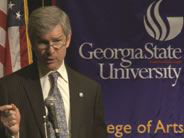 University President Mark Becker welcomed participants and audience members to the conference. He thanked SSI for partnering with Georgia State University on such an important topic and described the university's recent decision to provide targeted investment in faculty and doctoral students from the fields of computer science, communication studies, and religious studies to further expand research on transcultural conflict and violence at Georgia State University.
University President Mark Becker welcomed participants and audience members to the conference. He thanked SSI for partnering with Georgia State University on such an important topic and described the university's recent decision to provide targeted investment in faculty and doctoral students from the fields of computer science, communication studies, and religious studies to further expand research on transcultural conflict and violence at Georgia State University.
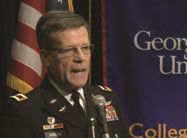 Colonel Lou Jordan welcomed the conference participants and audience members on behalf of SSI. He thanked Georgia State University for hosting the conference and described SSI's mission and its Academic Engagement Program.
Colonel Lou Jordan welcomed the conference participants and audience members on behalf of SSI. He thanked Georgia State University for hosting the conference and described SSI's mission and its Academic Engagement Program.
Keynote #1: Images of War/War of Images: A Brief History of Visual Persuasion and War.
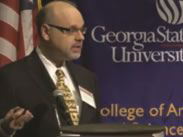 Dr. David Perlmutter, Director of the School of Journalism and Mass Communication and Professor of Mass Communication at the University of Iowa, is author/editor of nine books on political communication and persuasion. He identified recurrent themes associated with conflict images dating back to cave dwellers. He argued that a genuine understanding of how propaganda works requires an historical examination of what gives images power, and a firm grasp of the necessary conditions for contemporary audiences to accept the shared meaning of those images. The audience responded with questions about when and under what conditions images can confirm pre-existing biases within particular audiences.
Dr. David Perlmutter, Director of the School of Journalism and Mass Communication and Professor of Mass Communication at the University of Iowa, is author/editor of nine books on political communication and persuasion. He identified recurrent themes associated with conflict images dating back to cave dwellers. He argued that a genuine understanding of how propaganda works requires an historical examination of what gives images power, and a firm grasp of the necessary conditions for contemporary audiences to accept the shared meaning of those images. The audience responded with questions about when and under what conditions images can confirm pre-existing biases within particular audiences.
Panel #1: Perspectives from the Middle East.
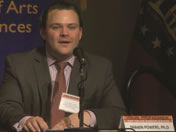 Dr. Shawn Powers, Assistant Professor at Georgia State University and Associate Director at the Center on International Media Education moderated the panel. He helped design and manage the University of Southern California Center for Public Diplomacy's evaluation of Alhurra, and co-led projects for the World Bank and Deutsche Welle on media development. He co-directs the Annenberg-Oxford Summer Institute on Media, Law, and Policy at Oxford University (UK), and is a commentator for CNN International, The Guardian, and National Public Radio.
Dr. Shawn Powers, Assistant Professor at Georgia State University and Associate Director at the Center on International Media Education moderated the panel. He helped design and manage the University of Southern California Center for Public Diplomacy's evaluation of Alhurra, and co-led projects for the World Bank and Deutsche Welle on media development. He co-directs the Annenberg-Oxford Summer Institute on Media, Law, and Policy at Oxford University (UK), and is a commentator for CNN International, The Guardian, and National Public Radio.
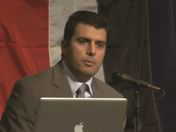 Dr. Jad Melki, Assistant Professor of Journalism and Media Studies at the American University of Beirut (AUB), discussed his media literacy program for AUB college students from Syria and Lebanon. He is the research director of the International Center for Media and the Public Agenda and formerly a broadcast and online journalist with more than 10 years of media experience. He was part of the Webby Award and Press Club Award winning Hot Zone Team (Yahoo News) covering the 2006 Israeli war with Lebanon.
Dr. Jad Melki, Assistant Professor of Journalism and Media Studies at the American University of Beirut (AUB), discussed his media literacy program for AUB college students from Syria and Lebanon. He is the research director of the International Center for Media and the Public Agenda and formerly a broadcast and online journalist with more than 10 years of media experience. He was part of the Webby Award and Press Club Award winning Hot Zone Team (Yahoo News) covering the 2006 Israeli war with Lebanon.
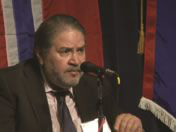 Dr. Hussein Amin, Professor and a former Chair of the Department of Journalism and Mass Communication at the American University in Cairo, discussed Internet regulation and censorship with a focus on Tahrir Square protests and the Egyptian Government's response. Dr. Amin is a senior fellow at the Adham Center for Television Journalism, former president of the Arab-U.S. Association for Communication Educators, and past chairman of the International Division of the Broadcast Education Association.
Dr. Hussein Amin, Professor and a former Chair of the Department of Journalism and Mass Communication at the American University in Cairo, discussed Internet regulation and censorship with a focus on Tahrir Square protests and the Egyptian Government's response. Dr. Amin is a senior fellow at the Adham Center for Television Journalism, former president of the Arab-U.S. Association for Communication Educators, and past chairman of the International Division of the Broadcast Education Association.
Two lines of inquiry emerged in the panel's conversation with an engaged audience. First, audience members wanted to know more about the training that Dr. Melki provides to his students and whether he is training future propagandists. He provided additional information about the program and argued that the training of critical thinking skills, which is necessary for evaluating propaganda efforts, outweighed the risk that he may be providing the skills necessary to engage in propaganda. Other audience members sought insight into the ongoing implications of the “Arab Spring.” All three of the panelists discussed their reflections on the revolutionary events in the region, contextualized their own experiences, and considered the relationship between activism and the new media in the Middle East.
Panel #2: Use of Visual Persuasion in the Online Environment.
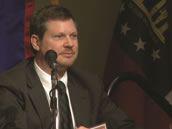 Colonel (Ret.) Doug Jordan, Chief of Cultural Programs in the Regional and Cultural Division of the Strategic Studies Department, Joint Special Operations University (JSOU), at MacDill Air Force Base, Tampa, Florida, served as the moderator for this panel. Prior to his arrival at JSOU, he served as a Counterinsurgency Information Operations Advisor to the International Security Assistance Force (ISAF), Kabul, Afghanistan. He is currently pursuing a doctoral degree in Communication at the University of South Florida.
Colonel (Ret.) Doug Jordan, Chief of Cultural Programs in the Regional and Cultural Division of the Strategic Studies Department, Joint Special Operations University (JSOU), at MacDill Air Force Base, Tampa, Florida, served as the moderator for this panel. Prior to his arrival at JSOU, he served as a Counterinsurgency Information Operations Advisor to the International Security Assistance Force (ISAF), Kabul, Afghanistan. He is currently pursuing a doctoral degree in Communication at the University of South Florida.
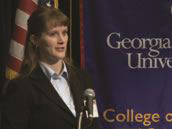 Anne Stenersen is a Research Fellow with the Terrorism and Political Violence Project at the Norwegian Defence Research Establishment (FFI). She compared pre-2001 videos produced by radical Islamist groups with those produced after 9/11. She noted similarities in the celebrated bravery, martyrdom, and brutality of commanders, and described differences such as the recurrent integration of Juba the “Badhdad Sniper” and “talking heads” (typically the leaders of the ideological movement added after 9/11).
Anne Stenersen is a Research Fellow with the Terrorism and Political Violence Project at the Norwegian Defence Research Establishment (FFI). She compared pre-2001 videos produced by radical Islamist groups with those produced after 9/11. She noted similarities in the celebrated bravery, martyrdom, and brutality of commanders, and described differences such as the recurrent integration of Juba the “Badhdad Sniper” and “talking heads” (typically the leaders of the ideological movement added after 9/11).
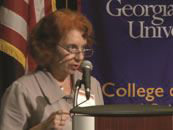 Dr. Cori Dauber, Associate Professor of Communication Studies at the University of North Carolina-Chapel Hill, a Research Fellow of the Triangle Institute of Strategic Studies, and Visiting Research Professor at the USAWC, discussed the use of logos, animations, and computer graphics in the videos produced by Islamist terrorist groups. She is the author of YouTube War: Fighting in a World of Cameras in Every Cell Phone and Photoshop on Every Computer (SSI, USAWC, 2009).
Dr. Cori Dauber, Associate Professor of Communication Studies at the University of North Carolina-Chapel Hill, a Research Fellow of the Triangle Institute of Strategic Studies, and Visiting Research Professor at the USAWC, discussed the use of logos, animations, and computer graphics in the videos produced by Islamist terrorist groups. She is the author of YouTube War: Fighting in a World of Cameras in Every Cell Phone and Photoshop on Every Computer (SSI, USAWC, 2009).
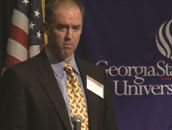 Dr. Scott Ruston, Assistant Research Professor with the Center for Strategic Communication of the Arizona State University, examined the role of narrative theory in extremist and counterextremist videos. After discussing stylistic elements such as "mash-ups," "DIY qualities," and bricolage, he advocated using narrative probability and fidelity to strengthen countermessaging strategies. He is the co-author of Narrative Landmines: Rumors, Islamist Extremism and the Struggle for Strategic Influence (Rutgers University Press, 2012).
Dr. Scott Ruston, Assistant Research Professor with the Center for Strategic Communication of the Arizona State University, examined the role of narrative theory in extremist and counterextremist videos. After discussing stylistic elements such as "mash-ups," "DIY qualities," and bricolage, he advocated using narrative probability and fidelity to strengthen countermessaging strategies. He is the co-author of Narrative Landmines: Rumors, Islamist Extremism and the Struggle for Strategic Influence (Rutgers University Press, 2012).
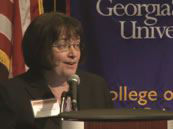 Dr. Carol Winkler, Associate Dean of Humanities and Professor of Communication Studies at Georgia State University, examined historical visual images of national apology to demonstrate how images of reconciliation, rather than apology, serve as more lasting responses to offending incidents that are circulating online. Her most recent book, In the Name of Terrorism: Presidents on Political Violence in the Post-World War II Era (SUNY, 2006), was awarded most outstanding book award in political communication by the National Communication Association.
Dr. Carol Winkler, Associate Dean of Humanities and Professor of Communication Studies at Georgia State University, examined historical visual images of national apology to demonstrate how images of reconciliation, rather than apology, serve as more lasting responses to offending incidents that are circulating online. Her most recent book, In the Name of Terrorism: Presidents on Political Violence in the Post-World War II Era (SUNY, 2006), was awarded most outstanding book award in political communication by the National Communication Association.
Audience questions for the second panel focused on how one can plan for the recirculation of mediated texts, if at all, and what precautions can be taken. Further, the audience asked questions about the methodological approaches utilized by the panelists.
Keynote #2: Now Media, Identity, and the Marketplace of Loyalty.
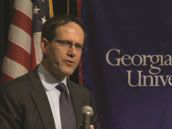 Matt Armstrong is the immediate past Executive Director of the United States Advisory Commission on Public Diplomacy. Currently, he is a consultant, lecturer, and author advising the U.S. Government on the strategic and operational structures, doctrine, and concepts that shape, empower, and limit U.S. public diplomacy and strategic communication. He also publishes www.MountainRunner.us, the premier blog on public diplomacy and strategic communication read by senior policymakers in the U.S. and abroad. Mr. Armstrong maintained that images and videos are part of competing discourses that are designed to inform, empower, and influence. The interconnected nature of audiences, with access to global communication technology, means that traditional affiliations are at risk and individuals' identities are in flux. He argued that we should now understand media as a marketplace for ideas in which the commodity bought and sold is the loyalty of the individual. Understood in this way, the Internet offers an additional marketplace for which clashing ideologies can compete.
Matt Armstrong is the immediate past Executive Director of the United States Advisory Commission on Public Diplomacy. Currently, he is a consultant, lecturer, and author advising the U.S. Government on the strategic and operational structures, doctrine, and concepts that shape, empower, and limit U.S. public diplomacy and strategic communication. He also publishes www.MountainRunner.us, the premier blog on public diplomacy and strategic communication read by senior policymakers in the U.S. and abroad. Mr. Armstrong maintained that images and videos are part of competing discourses that are designed to inform, empower, and influence. The interconnected nature of audiences, with access to global communication technology, means that traditional affiliations are at risk and individuals' identities are in flux. He argued that we should now understand media as a marketplace for ideas in which the commodity bought and sold is the loyalty of the individual. Understood in this way, the Internet offers an additional marketplace for which clashing ideologies can compete.
*****
The views expressed in this brief are those of the authors and do not necessarily reflect the official policy or position of the Department of the Army, the Department of Defense, or the U.S. Government.
*****
More information on the Strategic Studies Institute's programs may be found on the Institute's homepage at www.StrategicStudiesInstitute.army.mil.